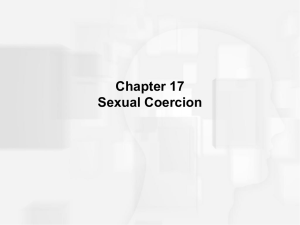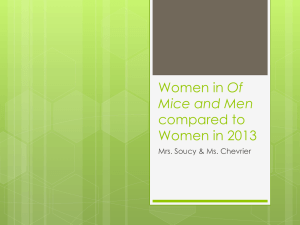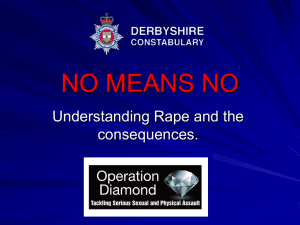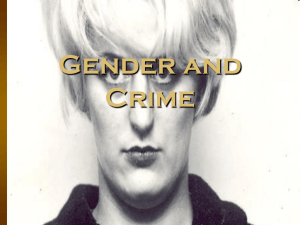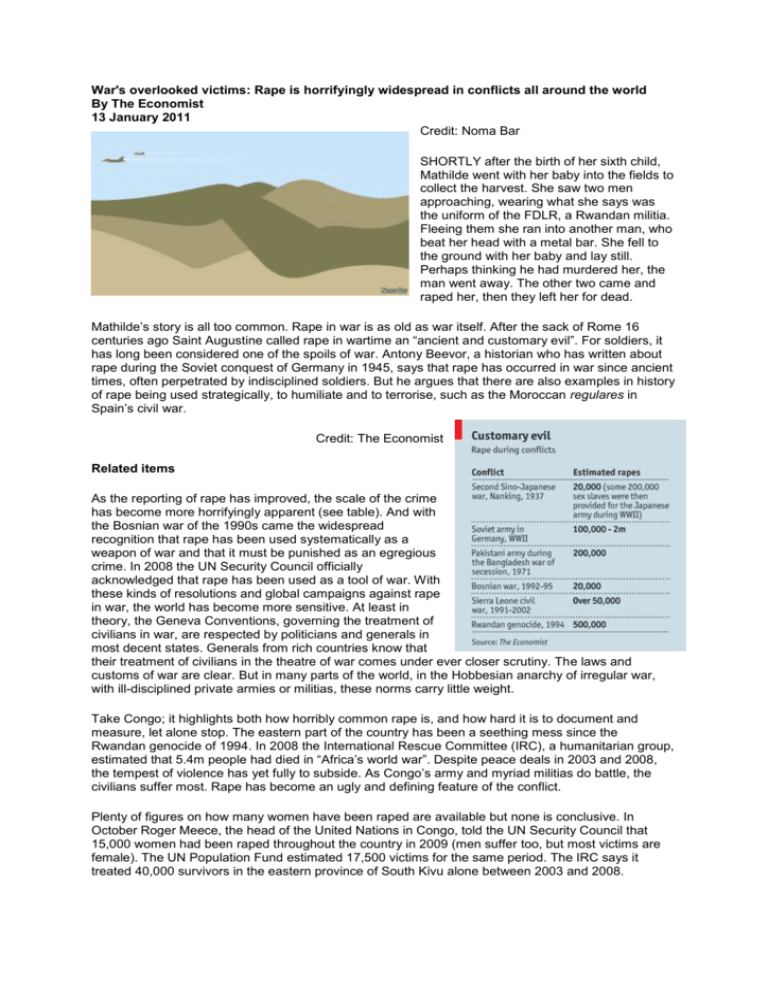
War's overlooked victims: Rape is horrifyingly widespread in conflicts all around the world
By The Economist
13 January 2011
Credit: Noma Bar
SHORTLY after the birth of her sixth child,
Mathilde went with her baby into the fields to
collect the harvest. She saw two men
approaching, wearing what she says was
the uniform of the FDLR, a Rwandan militia.
Fleeing them she ran into another man, who
beat her head with a metal bar. She fell to
the ground with her baby and lay still.
Perhaps thinking he had murdered her, the
man went away. The other two came and
raped her, then they left her for dead.
Mathilde’s story is all too common. Rape in war is as old as war itself. After the sack of Rome 16
centuries ago Saint Augustine called rape in wartime an “ancient and customary evil”. For soldiers, it
has long been considered one of the spoils of war. Antony Beevor, a historian who has written about
rape during the Soviet conquest of Germany in 1945, says that rape has occurred in war since ancient
times, often perpetrated by indisciplined soldiers. But he argues that there are also examples in history
of rape being used strategically, to humiliate and to terrorise, such as the Moroccan regulares in
Spain’s civil war.
Credit: The Economist
Related items
As the reporting of rape has improved, the scale of the crime
has become more horrifyingly apparent (see table). And with
the Bosnian war of the 1990s came the widespread
recognition that rape has been used systematically as a
weapon of war and that it must be punished as an egregious
crime. In 2008 the UN Security Council officially
acknowledged that rape has been used as a tool of war. With
these kinds of resolutions and global campaigns against rape
in war, the world has become more sensitive. At least in
theory, the Geneva Conventions, governing the treatment of
civilians in war, are respected by politicians and generals in
most decent states. Generals from rich countries know that
their treatment of civilians in the theatre of war comes under ever closer scrutiny. The laws and
customs of war are clear. But in many parts of the world, in the Hobbesian anarchy of irregular war,
with ill-disciplined private armies or militias, these norms carry little weight.
Take Congo; it highlights both how horribly common rape is, and how hard it is to document and
measure, let alone stop. The eastern part of the country has been a seething mess since the
Rwandan genocide of 1994. In 2008 the International Rescue Committee (IRC), a humanitarian group,
estimated that 5.4m people had died in “Africa’s world war”. Despite peace deals in 2003 and 2008,
the tempest of violence has yet fully to subside. As Congo’s army and myriad militias do battle, the
civilians suffer most. Rape has become an ugly and defining feature of the conflict.
Plenty of figures on how many women have been raped are available but none is conclusive. In
October Roger Meece, the head of the United Nations in Congo, told the UN Security Council that
15,000 women had been raped throughout the country in 2009 (men suffer too, but most victims are
female). The UN Population Fund estimated 17,500 victims for the same period. The IRC says it
treated 40,000 survivors in the eastern province of South Kivu alone between 2003 and 2008.
“The data only tell you so much,” says Hillary Margolis, who runs the IRC’s sexual-violence
programme in North Kivu. These numbers are the bare minimum; the true figures may be much
higher. Sofia Candeias, who co-ordinates the UN Development Programme’s Access to Justice project
in Congo, points out that more rapes are reported in places with health services. In the areas where
fighting is fiercest, women may have to walk hundreds of miles to find anyone to tell that they have
been attacked. Even if they can do so, it may be months or years after the assault. Many victims are
killed by their assailants. Others die of injuries. Many do not report rape because of the stigma.
Congo’s horrors are mind-boggling. A recent study by the Harvard Humanitarian Initiative and Oxfam
examined rape survivors at the Panzi Hospital in Bukavu, a town in South Kivu province. Their ages
ranged from three to 80. Some were single, some married, some widows. They came from all
ethnicities. They were raped in homes, fields and forests. They were raped in front of husbands and
children. Almost 60% were gang-raped. Sons were forced to rape mothers, and killed if they refused.
The attention paid to Congo reflects growing concern about rape in war. Historically the taboo
surrounding rape has been so strong that few cases were reported; evidence of wartime rape before
the 20th century is scarce. With better reporting, the world has woken up to the scale of the crime. The
range of sexual violence in war has become apparent: the abduction of women as sex slaves,
sexualised torture and mutilation, rape in public or private.
Credit: Dara Kay Cohen
In some wars all parties engage in it. In others it is
inflicted mainly by one side. Rape in wars in Africa has
had a lot of attention in recent years, but it is not just an
African problem. Conflicts with high levels of rape
between 1980 and 2009 were most numerous in subSaharan Africa, according to Dara Kay Cohen of the
University of Minnesota (see chart). But only a third of
sub-Saharan Africa’s 28 civil wars saw the worst levels of
rape—compared with half of Eastern Europe’s nine. And
no part of the world has escaped the scourge.
The anarchy and impunity of war goes some way to
explaining the violence. The conditions of war are often
conducive to rape. Young, ill-trained men, fighting far
from home, are freed from social and religious
constraints. The costs of rape are lower, the potential
rewards higher. And for ill-fed, underpaid combatants,
rape can be a kind of payment.
Widespread, but not inevitable
Then consider the type of wars fought today. Many recent conflicts have involved not organised
armies but scrappy militias fighting amid civilians. As wars have moved from battlefields to villages,
women and girls have become more vulnerable. For many, the home front no longer exists; every
house is now on the front line.
But rape in war is not inevitable. In El Salvador’s civil war, it was rare. When it did occur it was almost
always carried out by state forces. The left-wing militias fighting against the government for years
relied on civilians for information. You can rape to terrorise people or force them to leave an area,
says Elisabeth Wood, a professor at Yale University and the Santa Fe Institute, but rape is not
effective when you want long-term, reliable intelligence from them or to rule them in the future.
Some groups commit all kinds of other atrocities, but abhor rape. The absence of sexual violence in
the Tamil Tigers’ forced displacement of tens of thousands of Muslims from the Jaffna peninsula in
1990 is a case in point. Rape is often part of ethnic cleansing but it was strikingly absent here. Tamil
mores prohibit sex between people who are not married and sex across castes (though they are less
bothered about marital rape). What is more, Ms Wood explains, the organisation’s strict internal
discipline meant commanders could enforce these judgments.
Some leaders, such as Jean-Pierre Bemba, a Congolese militia boss who is now on trial for warcrimes in The Hague, say they lack full control over their troops. But a commander with enough control
to direct soldiers in military operations can probably stop them raping, says Ms Wood. A decision to
turn a blind eye may have less to do with lack of control, and more with a chilling assessment of rape’s
use as a terror tactic.
Rape is a means of subduing foes and civilians without having to engage in the risky business of
battle. Faced with rape, civilians flee, leaving their land and property to their attackers. In August rebel
militias raped around 240 people over four days in the Walikale district of eastern Congo. The motives
for the attack are unclear. The violence may have been to intimidate the population into providing the
militia with gold and tin from nearby mines. Or maybe one bit of the army was colluding with the rebels
to avoid being replaced by another bit and losing control of the area and its resources. In Walikale, at
least, rape seems to have been a deliberate tactic, not a random one, says Ms Margolis.
At worst, rape is a tool of ethnic cleansing and genocide, as in Bosnia, Darfur and Rwanda. Rape was
first properly recognised as a weapon of war after the conflict in Bosnia. Though all sides were guilty,
most victims were Bosnian Muslims assaulted by Serbs. Muslim women were herded into “rape
camps” where they were raped repeatedly, usually by groups of men. The full horrors of these camps
emerged in hearings at the war-crimes tribunal on ex-Yugoslavia in The Hague; victims gave evidence
in writing or anonymously. After the war some perpetrators said that they had been ordered to rape—
either to ensure that non-Serbs would flee certain areas, or to impregnate women so that they bore
Serb children. In 1995, when Croatian forces over-ran Serb-held areas, there were well-attested cases
of sexual violence against both women and men.
In the Sudanese region of Darfur, rape and other forms of sexual violence have also been a brutally
effective way to terrorise and control civilians. Women are raped in and around the refugee camps that
litter the region, mostly when they leave the camps to collect firewood, water and food. Those of the
same ethnicity as the two main rebel groups have been targeted most as part of the campaign of
ethnic cleansing. According to Human Rights Watch, rape is chronically underreported, partially
because in the mostly Muslim region sexual violence is a sensitive subject. Between October 2004
and February 2005 Médecins Sans Frontières, a French charity, treated almost 500 women and girls
in South Darfur. The actual number of victims is likely to be much higher.
Tacit approval
In the Rwandan genocide rape was “the rule and its absence the exception”, in the words of the UN. In
the weeks before the killings began, Hutu-controlled newspapers ran cartoons showing Tutsi women
having sex with Belgian peacekeepers, who were seen as allies of Paul Kagame’s Rwandan Patriotic
Front. Inger Skjelsbæk, deputy director of the Peace Research Institute in Oslo, argues that Hutu
propaganda may not have openly called for rape, but it certainly suggested that the Hutu cause would
be well served by the sexual violation of Tutsi women. Jens Meierhenrich, a Rwanda-watcher at the
London School of Economics, says that even if high-level commanders did not tell men to rape, they
gave tacit approval. Lower-ranking officers may have openly encouraged the crime.
Out of Rwanda’s horror came the first legal verdict that acknowledged rape as part of a genocidal
campaign. After the conviction of Jean Paul Akayesu, a local politician, the International Criminal
Tribunal for Rwanda said systematic sexual violence, perpetrated against Tutsi women and them
alone, had been an integral part of the effort to wipe out the Tutsis.
For combatants who know little about each other, complicity in rape can serve as a bond. The
Revolutionary United Front (RUF) in Sierra Leone, most of whose members say they were kidnapped
into its ranks and then raped thousands during the civil war, is a case in point. Ms Cohen argues that
armed groups that are not socially cohesive, particularly those whose fighters have been forcibly
recruited, are more likely to commit rape, especially gang rape, so as to build internal ties.
For the victims and their families, rape does the opposite. The shame and degradation of rape rip
apart social bonds. In societies where a family’s honour rests on the sexual purity of its women, the
blame for the loss of that honour often falls not upon the rapist, but the raped. In Bangladesh, where
most of the victims were Muslim, the use of rape was not only humiliating for them as individuals but
for their families and communities. The then prime minister, Mujibur Rahman, tried to counter this by
calling them heroines who needed protection and reintegration. Some men agreed but most did not;
they demanded sweeteners in the form of extra dowry payments from the authorities.
In Congo, despite the efforts of activists, rape still brings shame to the victim, says Ms Margolis:
“People can sit around and talk about the importance of removing the stigma in the abstract, but when
it comes to their own wives or daughters or sisters, it is a different story.” Many are rejected by their
family and stigmatised by their community after being raped.
There is little prospect of justice for the victims of rape. Mr Akayesu is one of the few people brought to
book for rape in war. Though wartime rape is prohibited under the Geneva rules, sexual violence has
often been prosecuted less fiercely than other war crimes. But the Balkan war-crimes court broke new
ground by issuing verdicts treating rape as a crime against humanity. The convictions of three men for
the rape, torture and sexual enslavement of women in the Bosnian town of Foca was a big landmark.
But in Congo the court system is in pieces. There have been fewer than 20 prosecutions of rape as
either a war crime or a crime against humanity. The American Bar Association, which helps victims
bring their cases to court in eastern Congo, has processed around 145 cases in the past two years.
This has resulted in about 45 trials and 36 convictions based on domestic legislation, including a law
introduced in 2006 to try and address the problem of sexual violence. Those who work with the
survivors of rape in Congo have mixed feelings about the 2006 law. It has pricked consciences and
made people more aware of their rights, concedes Ms Margolis. It creates a theoretical accountability
that could help punish perpetrators. But for women seeking justice, it has yet to have much impact.
“There is still a glimmer of hope in people’s eyes when they talk about the law. But the judicial and
security systems need to be improved so that it can be applied better, or people may lose confidence
in it,” Ms Margolis says.
Huge practical problems beset the legal system in Congo, says Richard Malengule, head of the
Gender and Justice programme at HEAL Africa, a hospital in Goma. People have to walk 300km to
get to a court. There is no money and no training for the police. Even if people are arrested, they are
often released within a few days, in many cases by making a deal with the victim’s family or the court.
Those that go to jail often escape within days. Many prisons have no door—or corrupt guards.
Enduring effects
Given the parlous state of Congo’s judiciary, raising the number of prosecutions may not help. Some
want more international involvement. Justine Masika, who runs an organisation in Goma seeking
justice for the victims of sex crimes, says Congolese courts must work with international ones in
prosecuting rape. But “hybrid” courts require some commitment from the local government; Congo’s
rulers do not show much commitment to tackling rape. The International Criminal Court is investigating
crimes, including rape, in Congo but gathering necessary evidence is hard.
Raising global awareness is another avenue; it helps lessen the stigma. Various UN resolutions over
the past ten years have highlighted and condemned sexual violence against women and girls and
called on countries to do more to combat it. But worthy language will not be enough.
Worse, the UN has faced criticism for failing to protect Congolese civilians from rape. In the Walikale
attack, one UN official worries that the body is not meeting its obligations to protect civilians. He
accepts that in remote places it is hard for peacekeepers to reach civilians, but insists that this does
not justify the UN’s failure in Walikale. He is dubious, too, about the investigations into the incident.
“All these interviews, these investigations, what have they achieved? The survivors are interviewed
again and again and again? Where does that get them?”
Without the presence of the UN, atrocities would be even more widespread, says Mr Malengule. But in
the long term, he says, more pressure must be put on Congo’s government to tackle rape. At present,
one aid worker laments, it just gets a lot of lip-service. The government would rather Congo were not
known as the world’s rape capital, but it shows little interest in real change.
Even when wars end, rape continues. Humanitarian agencies in Congo report high levels of rape in
areas that are quite peaceful now. Again, it is hard to assess numbers. Figures for rape before the war
do not exist. A greater willingness to report rape may account for the apparent increase. But years of
fighting have resulted in a culture of rape and violence, says Mr Malengule. Efforts to reintegrate excombatants into society have been short and unsuccessful, with little follow-up to assess results. Add
to that the dismal judicial system, and the outlook is grim.
It is bleaker still when you see how long rape’s effects endure. Rebels seized Angelique’s village in
1994. They slit her husband’s throat. Then they bound her between two trees, arms and legs tied
apart. Seven men raped her before she fainted. She does not know how many raped her after that.
Then they shoved sticks in her vagina. Tissue
between her vagina and rectum was ripped,
and she developed a fistula. For 16 years she
leaked urine and faeces. Now she is getting
medical treatment, but justice is a distant
dream.
Credit: Noma Bar
Copyright 2011 The Economist




